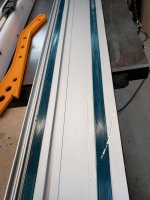[quote author=Packard link=topic=75084.msg727093#msg727093 date=1736455675]
I wanted to see what kick-back on a track saw looked like. Google provides some looks.
[unsure]
I do not see what this guy did wrong. I could see myself making the same cut. But I always use two hands on the saw. This guy weirdly keeps one hand inside his apron.
[/quote]
His YouTube page contains this information
After a serious car accident in May, 2018 | suffered nerve damage and lost the use of my dominant right hand and arm.
I admit it did take more than a few seconds to get this information [unsure]
I wanted to see what kick-back on a track saw looked like. Google provides some looks.
[unsure]
I do not see what this guy did wrong. I could see myself making the same cut. But I always use two hands on the saw. This guy weirdly keeps one hand inside his apron.
[/quote]
His YouTube page contains this information
After a serious car accident in May, 2018 | suffered nerve damage and lost the use of my dominant right hand and arm.
I admit it did take more than a few seconds to get this information [unsure]


